#1830s bodice
Explore tagged Tumblr posts
Text

Mourning Bodice, Silk Trimmed with Silk Crepe, Late 1830s
From The John Bright Collection
#bodice#dress bodice#mourning#fashion#fashion history#silk#crepe#late 1830s#1830s#1800s#19th century#history
124 notes
·
View notes
Photo
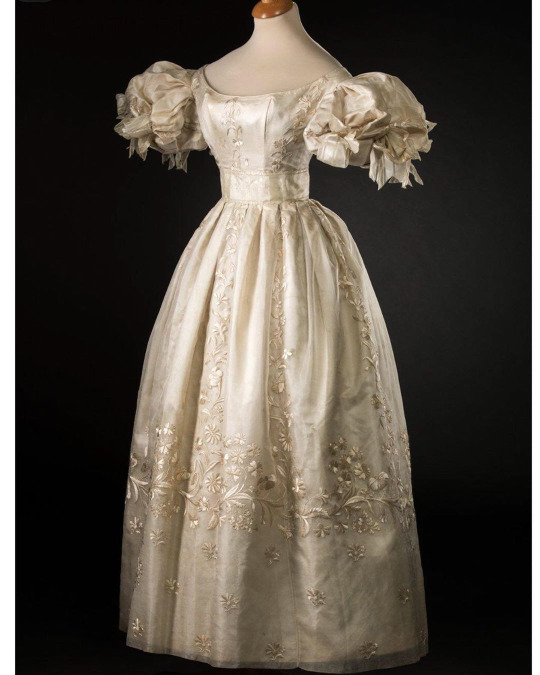
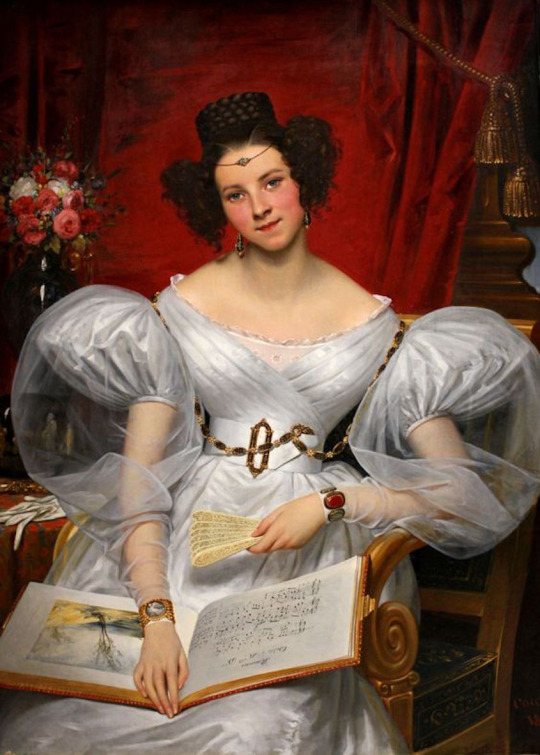




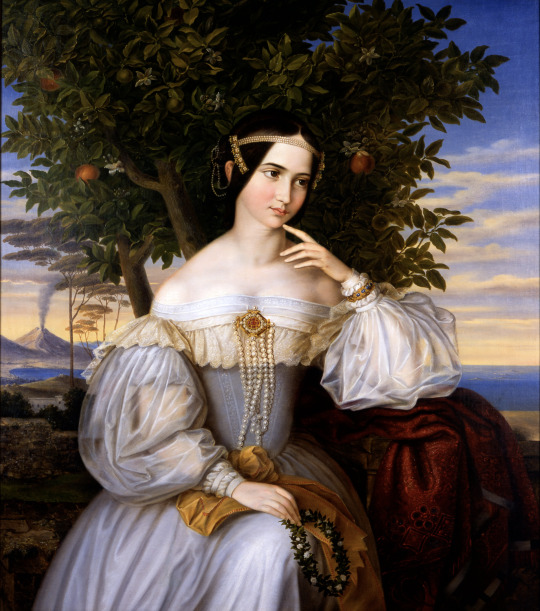
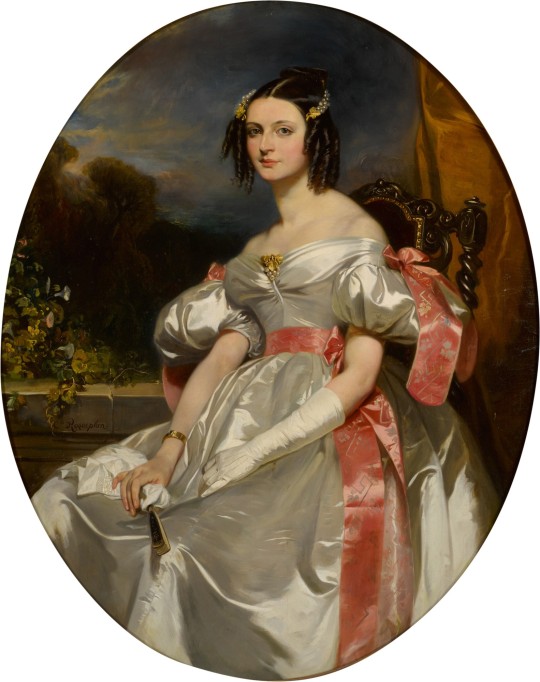
More pre-Victorian 1830s (from top to bottom) -
ca. 1830 Evening or wedding dress (location ?). From tumblr.com/andrayblue 1080X1350.
1831 Marquise Chasseloup-Laubat (probably Marie Augustine Antoinette Le Boucher des Fontaines) by Joseph-Désiré Court (Musée des Beaux-Arts de Rouen - Rouen, Normandie, France). From their Web site' enlarged by half 845X1181.
1830-1832 María Cristina de Borbón, Queen of Spain by José de Madrazo y Aguado (Prado). From their Web site 1280X1745.
1832 Marie Franziska von Freytag by ? (Salzburg Museum - Salzburg, Salzburgland, Austria). From tumblr.com/history-of-fashion 766X963.
1832 Amalie Klein by Friedrich von Amerling (Österreichische Galerie Belvedere - Wien, Austria). From tumblr.com/history-of-fashion; fixed spots & cracks throughout w Pshop 2893X3508.
1835 Illustration from La Mode by Paul Gavarni. From tumblr.com/clove-pinks 1650X2048.
1836 Marriage Portrait of Charlotte de Rothschild by Moritz Daniel Oppenheim (Israel Museum - Jerusalem, Jerusalem District, Israel). From Google Art Project.
Lady with Pink Sash by Camille Joseph Etienne Roqueplan (Sotheby's - 29Jan22 auction Lot 703) 1583X2000.
#1830s fashion#Romantic era fashion#Biedermeier fashion#Louis-Philippe fashion#natural waistline#Marquise Chasseloup-Laubat#Joseph-Désiré Court#cross over bodice#chemise#quarter-length puffed inner sleeves#long sheer outer sleeves#ferroniere#María Cristina de Borbón#court dress#Marie Franziska von Freytag#Apollo knot#Amalie Klein#Friedrich von Amerling#Gigot sleeves#Paul Gavarni#Charlotte de Rothschild#Moritz Daniel Oppenheim#Camille Joseph Etienne Roqueplan#waist band#full skirt
392 notes
·
View notes
Text

Mourning bodice, late 1830s
Silk trimmed with silk crape; unrelated chemisette
4 notes
·
View notes
Text

Bodice and apron 1830s
1K notes
·
View notes
Text

Lady Ross and Miss Crozier attending a ball to honour their successes in polar exploration. Frances hates the limelight, but for Jane she’ll go
Rossier For @terroryuriweek Day 2, 1840s Fashion
JCR is wearing a silhouette fashionable for the early to mid 40s, a fitted bodice and wide skirts, while I tried to draw Frances in a dress that would be more appropriate for the 1830s. Even then it doesn’t have the puffed sleeves associated with the time
138 notes
·
View notes
Text

Ball Gown
1840s
"
This is a striking example of how 18th-century fabric was treasured. The textile was probably originally a 1740s dress which was taken apart and then reconfigured into this fashionable dress in the early 1840s. The elongated waist and V-shaped bodice front emphasize the bust and wide shoulders and were key features of the dresses of the period.
The female silhouette of the middle of the 19th century consisted of a fitted corseted bodice and wide full skirts. The conical skirts developed between the 1830s, when the high waist of the Empire silhouette was lowered and the skirts became more bell shaped, to the late 1860s, when the fullness of the skirts were pulled to the back and the bustle developed. The flared skirts of the period gradually increased in size throughout and were supported by a number of methods. Originally support came from multiple layers of petticoats which, due to weight and discomfort, were supplanted by underskirts comprised of graduated hoops made from materials such as baleen, cane and metal. The fashions during this time allowed the textiles to stand out because of the vast surface areas of the skirt and a relatively minimal amount of excess trim.:
298 notes
·
View notes
Text
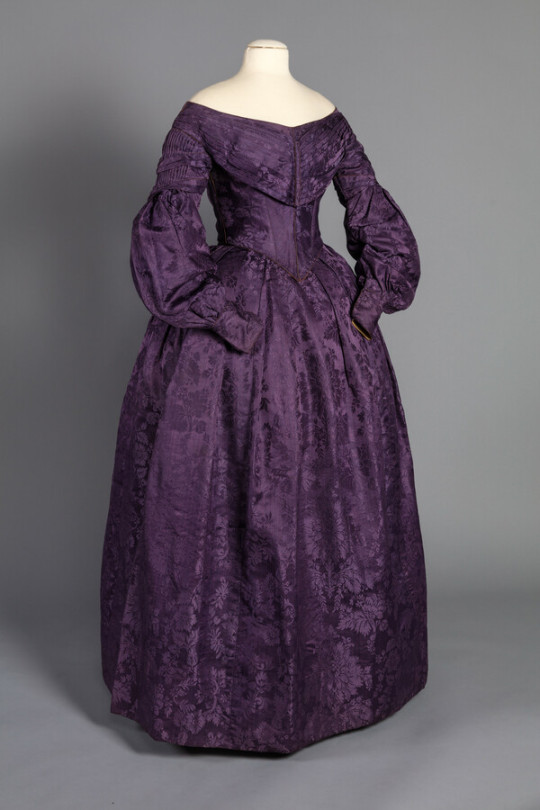
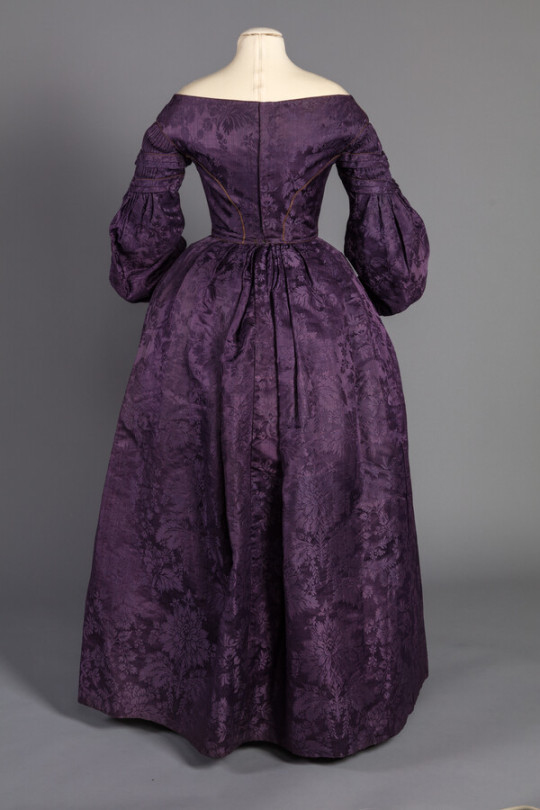
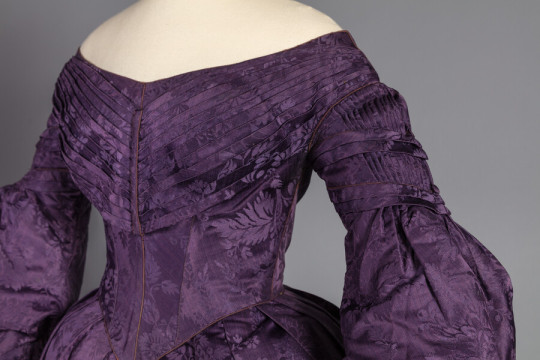
Oh, saints. This dress combines so many things I love in one place!
First of all, we’re in the late 1830s (by my guess), a time of dress transition. You can see the influence of the Romantic with those sleeves, but the hint of later Victorian gowns in the bodice shaping. The particular bodice here is fan-pleated, which is pretty self-explanatory if you look at the way the fabric is both pleated and fanned out. I do adore the result.
But, ahem, that damask? That color? Purple, always. Of course. For a 200 year old dress, the hue is still so striking. It is not Perkins Purple, however, as it’s two decades too early for that.
The weave? I damn near fell out of my chair looking at it. It’s one of those cases where I wish there were even higher resolutions so I could zoom in and see the stitches. Alas, we are not yet there in terms of technology, so I will instead cope with this.
And then it gets better. Because that silk damask? It’s almost 100 years older than the dress itself. UGH I LOVE IT SO MUCH. Could it have been Spitalfields? Maybe! It’s hard to say because we don’t have the provenance.
From the Maryland Center for History and Culture.
#silk dress#1830s#fashion history#textiles#costume history#historical costuming#history of fashion#costume#threadtalk#19th century fashion#historical fashion#spitalfields silk#damask
2K notes
·
View notes
Text

L'Art et la mode, no. 42, vol. 15, 20 octobre 1894, Paris. Créations inédites. Dessin de C. Billié. Bibliothèque nationale de France
Toilette de ville en drap mastic, brodé au plumetis sur un dessous de velours hanneton. Corsage de velours garni de bretelles formant choux à la taille. Manches larges, poignets drap brodé. Chapeau 1830, en feutre mastic, garni de velours hanneton.
City ensemble in mastic cloth, embroidered with plumetis on a chafer velvet underside. Velvet bodice trimmed with straps forming cabbages at the waist. Wide sleeves, embroidered cloth cuffs. 1830 hat, in mastic felt, trimmed with chafer velvet.
—
Robe de visites, en velours Parme, brodée de jais, garnie de vison et de velours aubergine. Manches toutes brodées. Chapeau en feutre noir, garni de plumes et de roses de velours aubergine.
Visiting dress, in Parma velvet, embroidered with jet, trimmed with mink and aubergine velvet. Fully embroidered sleeves. Black felt hat, trimmed with feathers and aubergine velvet roses.
—
Collet en fourrure, garni de velours gris mauve rebrodé formant longues pointes devant. Choux aux épaules. Capeline Louis XVI, garnie de plumes noires et de violettes.
Fur collar, trimmed with mauve-gray velvet embroidered into long points at the front. Shoulder puffs. Louis XVI wide-brimmed hat, trimmed with black and violet feathers.
—
Collet en velours noir et moire blanche brodée de jais. Bord de plumes noires, bretelles en velours noir. Chapeau "petit abbé", garni de plumes.
Collar in black velvet and white moire embroidered with jet. Edge of black feathers, straps in black velvet. "Petit abbé" hat, trimmed with feathers.
—
Manteau de voiture, en velours noir et hermine, rattaché aux épaules par des motifs de jais et cabochons; revers en soie vieux rose, avec jais en bas. Toque en plumes noires et velours vieux rose. — Manchon velours.
Car coat, in black velvet and ermine, attached at the shoulders with jet and cabochon motifs; old pink silk lapels, with jet at the bottom. Black feather and old pink velvet toque. — Velvet muff.
#L'Art et la mode#19th century#1890s#1894#on this day#October 20#periodical#fashion#fashion plate#description#bibliothèque nationale de france#dress#coat#cape#gigot#Modèles de chez#C. Billiè#collar
91 notes
·
View notes
Text

Bodice
DATE: 1830-35
PLACE MADE: Germany, Europe
MEDIUM: silk, cotton
131 notes
·
View notes
Note
Costume related question - in Nosferatu Anna Harding wears a yellow dress with "cold shoulders" where the sleeves don't fully connect to the bodice which really confused me since the rest of the movie features such meticulously recreated historical costuming, was that a thing in the 1830s? Or is this a stylistic choice on the part of the costume designer?
Unless it's a very specific fashion plate I've never seen before, that's pure fantasy on the part of the designer. Which is weird given how much the rest of the costumes look utterly perfect for the time period!
I've never seen anything like a cold shoulder dress before the early 20th century, but if anyone can show me an example, I will believe it 
27 notes
·
View notes
Text

"And by the way, Monsieur Marius, I believe that I was a little bit in love with you." (Les Misérables – Victor Hugo, 1862)
next up, the 1860s!! there was a lot going on during this decade, so i once again tried to keep a mix of upper and lower class fashions, as well as throwing in a few more "pioneer" esque dresses. after all, there's only so many petticoats you can wear when your oxen die and you have to walk!
hoop skirts would reach their peak in the middle of this decade, and from there the shape would become elliptical, with most of the "hoop" moving to the back. this would eventually become the "bustle". corsets were still worn, but with the layering and vastness of skirts, the size of the waist would already look smaller in comparison. hairstyles were lower, buns being held at the nape of the neck more often than not. heeled boots were back in style, as you might catch a glimpse of them as fabric moved due to the cage crinoline. near the end of the decade, it became more common to see skirts paired with shirtwaists or blouses instead of matching bodices.
1800-1809 / 1810-1819 / 1820-1829 / 1830-1839 / 1840-1849 / 1850-1859
cc links under the cut!
see resources post for genetics
galateia : buzzardly28's margot hair / nissasims' victorian crinoline
gelsomina : buzzardly28's nell hair / linzlu's fancy bonnet / linzlu's mary louise walking dress
gheta : buzzardly28's 1860s hair #1 / theroyalthornoliachronicles' elisabeth swiss dress recolor
gigi : buzzardly28's penelope hair + hair pearls / simstomaggie's marigold dress
glendora : okruee's georgia hair / historicalfictionsims' ruth dress / kedluu's ankle boots
godeliva : simstomaggie's violet hair + leonore dress
greta : buzzardly28's penny hair / lace-and-honey's linzlu prairie bonnet conversion / johnny149's old west hoop dress recolors
guiying : the-melancholy-maiden's oregon trail bonnet / elfdor's old west teacher's dress
gwendoline : buzzardly28's 1860s hair #2 / linzlu's birthday bonnet / simstomaggie's syndicate dress recolor
gyovanna : buzzardly28's pippa hair / linzlu's fancy bonnet / dzifasims' garibaldi dress
thank you to @buzzardly28 (a LOT of thanks) @linzlu @theroyalthornoliachronicles @batsfromwesteros @simstomaggie @okruee @historicalfictionsims @kedluu @lace-and-honey @the-melancholy-maiden @elfdor and @dzifasims
again, to everyone thats getting tagged over and over: i'm sorry
#my sims#sims 4 lookbook#ts4lookbook#sims 4 historical lookbook#ts4historicallookbook#ts4 lookbook#ts4 victorian lookbook#ts4 victorian#sims 4 victorican#223 years#historical#victorian#1860s
197 notes
·
View notes
Text
Fashions of the Early 1830s: Large Hats and Leg-o-Mutton Sleeves
I was obsessed with Victorian era fashion for way too long! Let's jump back a few years and take a look at what royals and high-society women were wearing from 1830 to about 1836.

Vincente López Portaña (Spanish, 1772–1850) • Maria Cristina de Bourbon, Queen of Spain (fourth wife of Fernando VII) • 1830 • Museo Nacional del Prado, Madrid
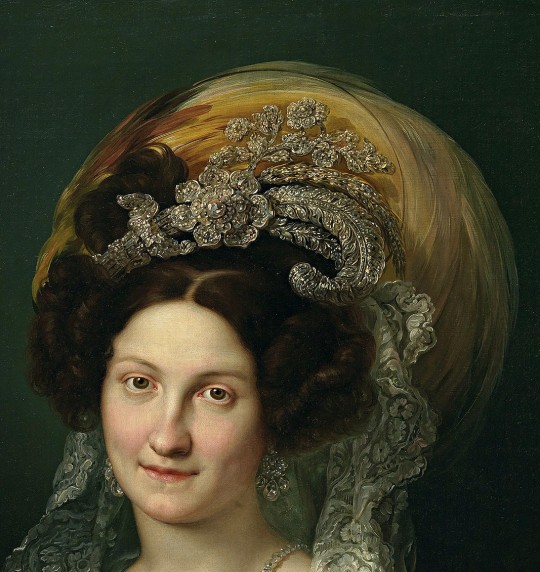
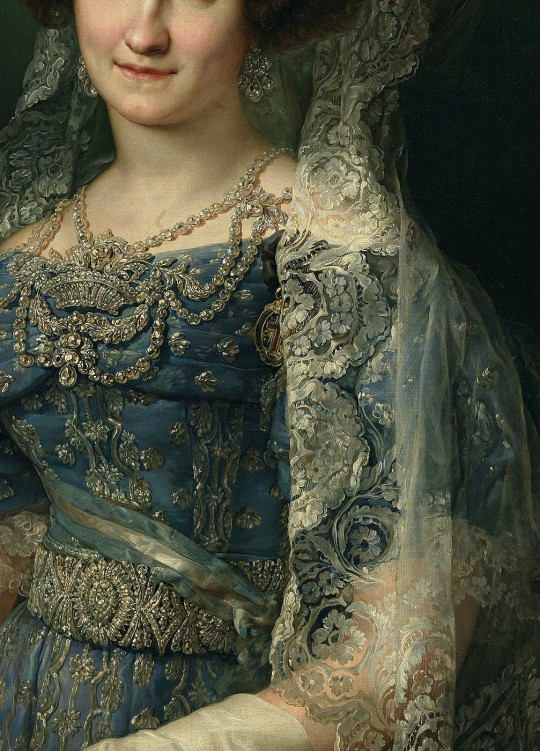
The style of the blue gown above is in keeping with Romantic era fashion, with its elbow-length puff sleeves with lace trim and pleated bodice. For formal attire, long gloves were worn.
The Maria Cristina de Bourbon portrait is of a royal subject, therefore the jewel-studded headpiece is especially grand, as is the bodice ornament and earrings. The feather was characteristic of the times – very large hats with feathers were in vogue, as well as large bonnets. The Spanish queen is wearing a lace mantila with her headpiece, which I assume is a symbol of her Spanish heritage.
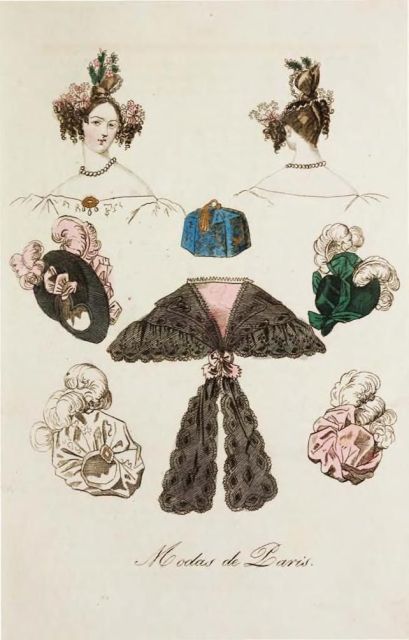
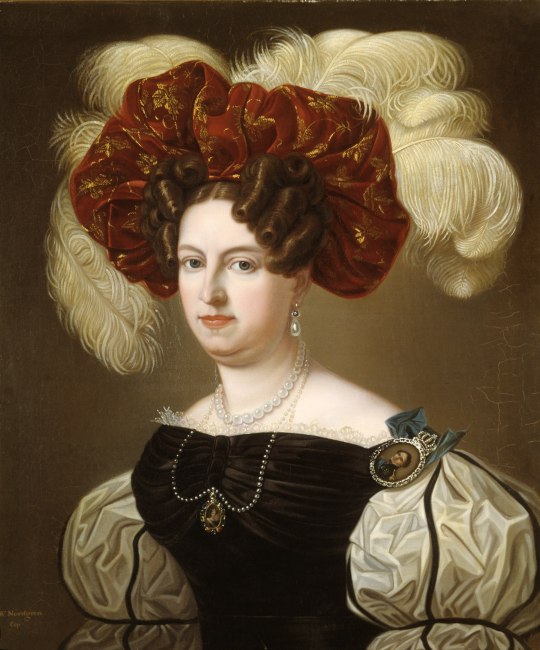
The fabric of the queen's dress is extraordinarily elaborate, with all-over silver thread embroidery. The bodice on this and many early to mid 1830s dresses was called a bodice à la Sevigne, which was made up of a central boned band divided into horizontal folds of fabric.
Belts and wide ribbons around the waist were often featured on dresses of the early to mid 1830s.
The fashion from circa 1830 to 1835 was one of over-porportioned extravagance. Sleeves larger than were ever seen or since been, width at the shoulders, and dramatic hats and headpieces.
Hair too was over-the-top. Notice the perponderance of elaborate braids, coils, and curls in these images.
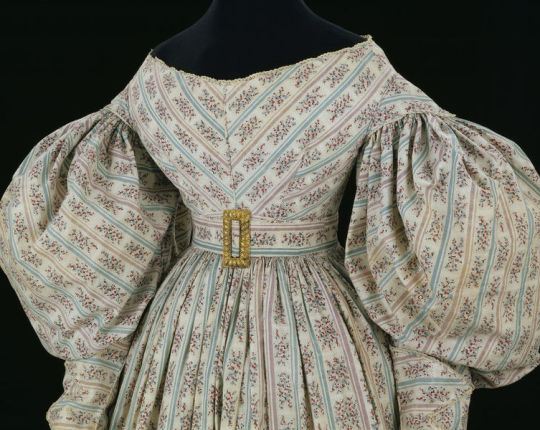
1830-34 • British • Printed Cotton Day Dress • Victoria and Albert Museum
One such dramatic feature of 1830s fashion was the pelerine, a lace covering that was worn over the shoulders. The cut of the neckline was already exagerated to emphasize width at the shoulders; adding a pelerine only added to that width as well further acting as more ornamentation to the outfit.
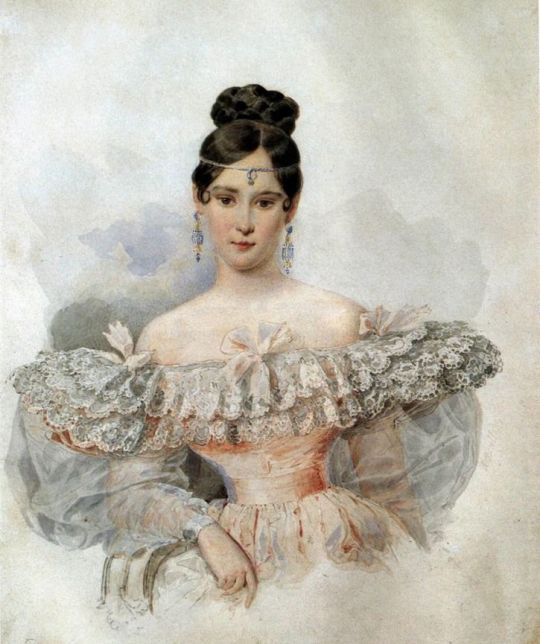
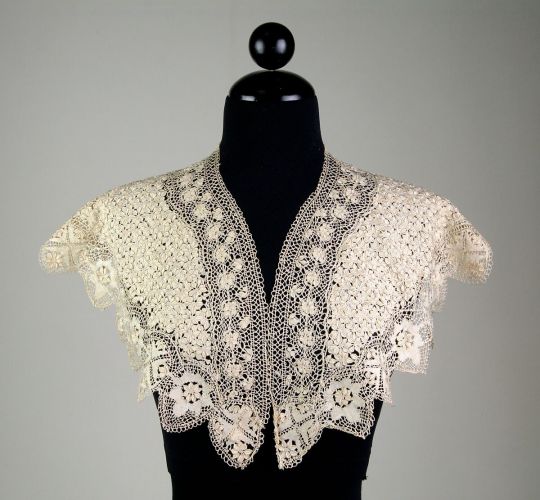

François-Joseph Navez (Belgian, 1787-1869) • Théodore Joseph Jonet and his two daughters • 1832 • Private collection
Sleeve style quickly evolved from simply puffy to Gigot or leg-o-mutton sleeves – a huge, billowy sheer sleeve over a smaller one, continuing with a tight-fitting long sleeve.
This flamboyance in sleeves was to suddenly come to an end around 1836. More about that in a future post, as I continue to flit willy-nilly along the fashion history timeline!
References:
• Fashion History Timeline: 1830-1839
• Wikipedia: 1830s in Western Fashion
• Wikipedia: Pelerene
• Mimi Mathews: The 1830s in Fashionable Gowns: A Visual Guide to the Decade
#art#portrait#painting#fashion history#royal portraits#fine art#art history#romanticism and fashion#1830s fashion#historical fashion#art & fashion#family group#the resplendent outfit blog#art & fashion blog
33 notes
·
View notes
Text
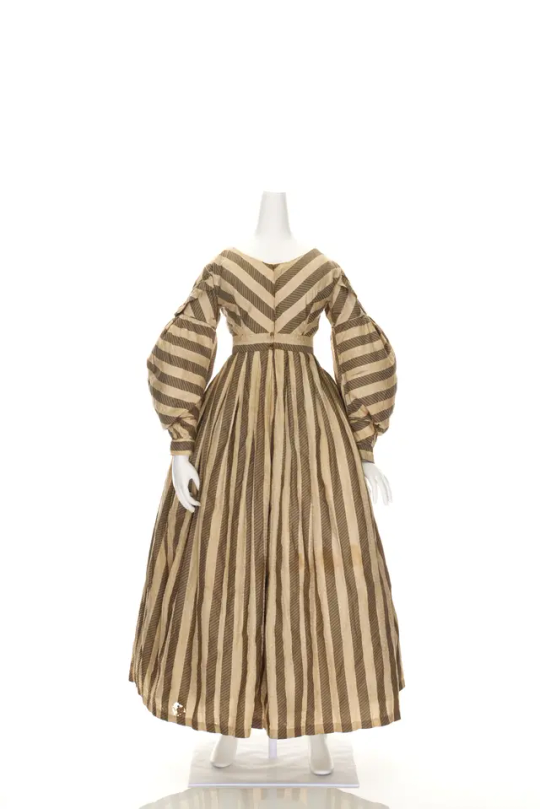
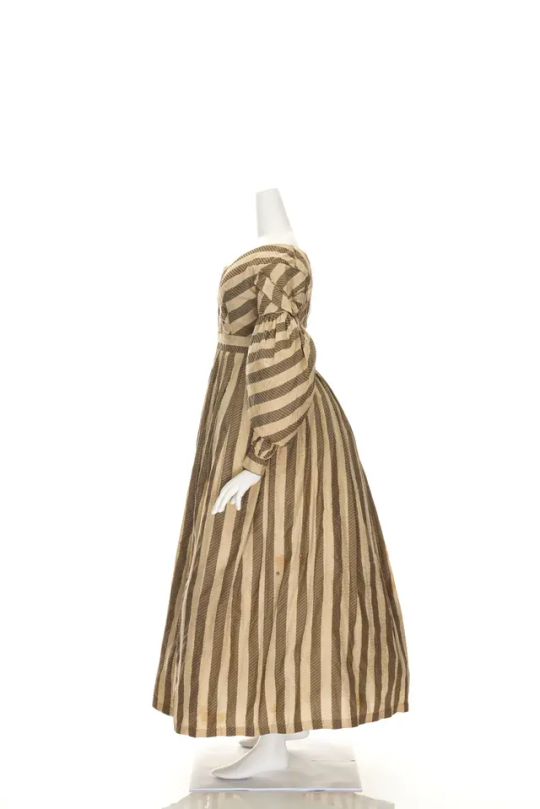
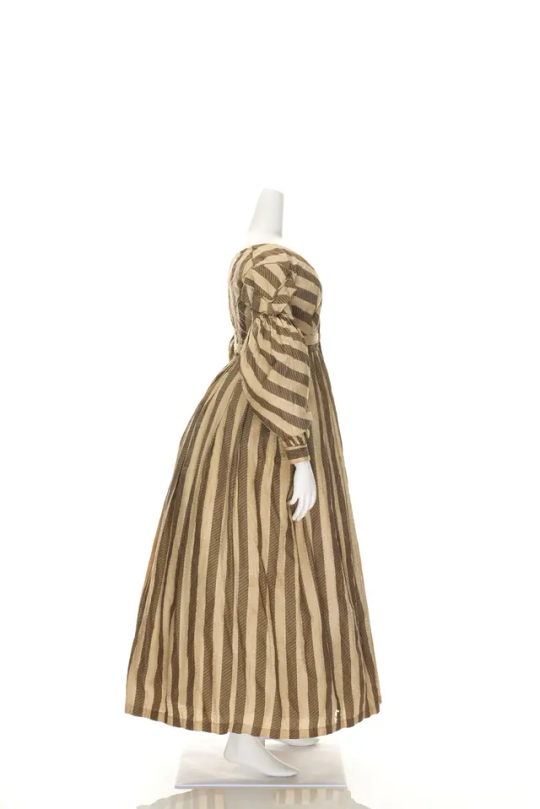
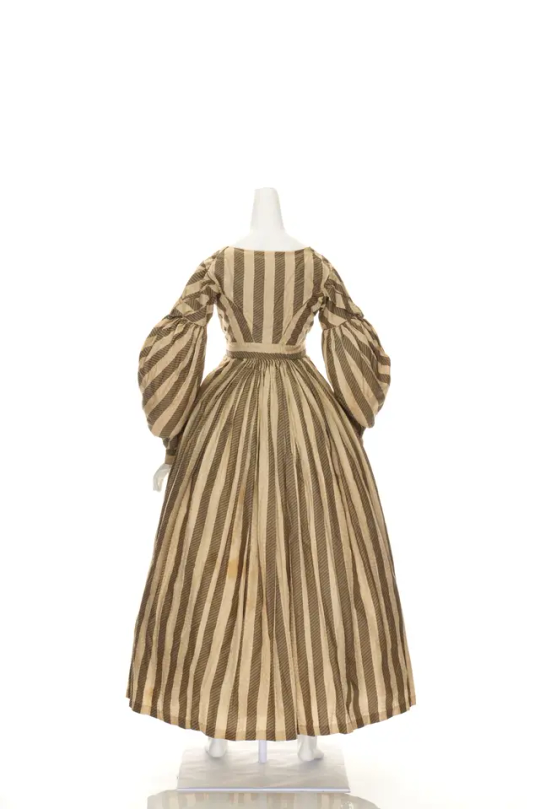
Day dress worn by Elizabeth Marsden
Powerhouse Collection
This day gown is one of a number of costumes in the Museum's collection that were worn by members of the Marsden family. It is likely that the dress was worn by Elizabeth Marsden, the wife of Reverend Samuel Marsden who was a prominent figure in colonial New South Wales. On 1 January 1793 Marsden accepted the appointment as assistant to the chaplain of New South Wales, and was ordained deacon on 17 March at Bristol and priest in May of the same year. Marsden married Elizabeth Fristan on 21 April 1793 and the newly married couple, expecting their first child, left London on 1 July 1793 on the ship 'William'. They arrived in Port Jackson in March 1794 with their daughter Ann, who was born during the eight month journey. As the chaplain to New South Wales, Marsden endeavoured, with some success, to improve the standard of morals and manners. Samuel soon became a leading figure in colonial life, combining, sometimes controversially, his job as the colony's clergyman with that of magistrate, missionary, wealthy landowner and farmer.
Life in the new colony proved extremely isolating. In 1796 Elizabeth Marsden wrote: 'We seem in our present situation to be almost totally cut off from all connexion with the world especially the virtuous part of it. Old England is no more than like a pleasing dream' (Marsden 1796). However, right from the beginning, the colonists of the remote penal settlement that became Sydney wanted to maintain a fashionable appearance. For Sydney's elite, fashionable dress confirmed their status in the colony, clearly defining not just wealth but also their moral superiority. It was to Britain and France that they looked for news of the latest fashions and hand coloured fashion plates inserted in monthly periodicals provided them with details of the latest silhouettes, hairstyles and accessories. More immediate news was obtained by examining the dress of women of the latest shipboard arrivals from England. The colonial elite, including the family of Samuel Marsden, eagerly awaited the irregular shipments of goods from Europe, India and China. At first the lack of local stores, dressmakers, tailors and supplies meant they frequently relied on friends and family 'at home' to purchase and ship the latest styles. In 1799 Elizabeth Marsden wrote to Mary Stokes, a friend in England: 'We are surprised to see the alteration in the fashion. The Bonnet with white satin ribbons is much admired. Dear Madam your goodness induces me to take the liberty to say a little white ribbon would be acceptable' (Marsden 1799). By the 1820s commerce was thriving and a wide range of dressmaking and tailoring skills were locally available, however many still preferred the prestige of a European import.
It is likely that this dress was worn by Elizabeth Marsden in about 1835 when she was nearly 60. Elizabeth died the same year and the dress may have been kept by her children or husband as a momento. The dress shows some of the stylistic irregularities often encountered in colonial dress. The front-opening bodice of the dress is unusual for this time, which may suggest that it was remade from an earlier gown. Another possibility is that the front opening made it easier for Elizabeth to dress, as she had suffered a stroke in 1811 whilst giving birth to her daughter Martha on 6th May 1811, leaving one arm paralysed. The other alternative is that the dress belonged to Ann and was a nursing dress which opened at the front to allow for breastfeeding.
Distinctive of the fashion during the 1830s are the bishop sleeves with flat mancherons off the shoulders, together with the pleated skirt. The dress is well made and finished which, along with the quality of the fabric, indicates the use of a professional dressmaker. However Ann Marsden was known to have been a skilled seamstress and may have made the dress. As with other costumes worn by the Marsden family, this dress appears restrained in style but of good quality fabric and finish, reflecting the Marsden family's social position and comfortable economic circumstances.
The Marsden costume collection was transferred from the Royal Australian Historical Society to the Museum in 1981. This well-provenanced collection includes some of the earliest surviving examples of colonial dress worn and made in Australia, and gives insight into the life of the Marsden family.
Michelle Brown, 2007
90 notes
·
View notes
Text
Happy Floral Friday🌹

This ca.1830 nursing day dress is from the V&A collection.
I'm super into anything that looks like Grandma's curtains at the moment.
Anyway...
Here's the Physical description from the V&A website:
"Day dress hand-made from block-printed cotton and lined with cotton. Cut and constructed for nursing.
The dress has a shallow wide neckline and long sleeves which are full at the sleevehead and tapers towards the wrist. The sleeve ends are finished with self-cuffs which are cut to wrap over and form a diagonal line, which is trimmed along the outside edge with six tiny gilt-metal, non-functional buttons. The cuffs fasten with hooks and eyes. The front panels of the bodice are decorated over the breasts with a pair of horizontal self-pleats which meet in a V-shape at the centre front. The dress has a slightly raised waist and a full bell-shaped skirt which is gathered into the waist. The hem of the skirt is trimmed with a deep self-flounce. The bodice has a loose panel which could be unfastened at the waist and lifted for nursing. The design of the print sets boldly drawn flower stems, which include marigolds, heather and valerian rendered in pink, yellow, green and indigo, on a vivid madder ground. The fabric was probably printed with indigo and madder by the 'Turkey red' resist process and overprinted with yellow to form orange and green."
100 notes
·
View notes
Text


Beige Taffeta Dress, ca. 1830, American.
MFA Boston.
#womenswear#mfa boston#extant garments#silk#dress#taffeta#beige#usa#american#19th century#1830#1830s#1830s usa#1830s dress#spitalfields silk
108 notes
·
View notes
Text
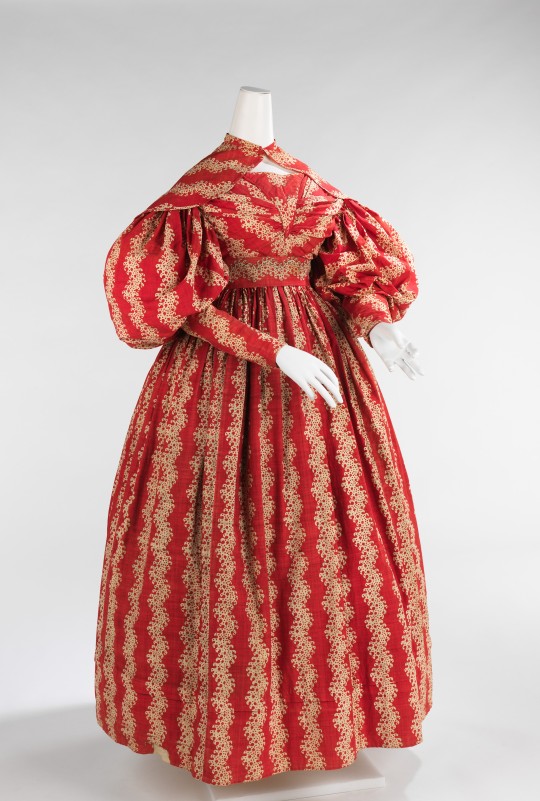
Dress
1830s
The Metropolitan Museum of Art
The 1830s are the 1970s of the 19th century. Fashion was big and over-the-top and often gets maligned as the ugliest decade of the century, but I love the camp of it.
"This transitional style indicates the aesthetic of its period. The large gigot sleeves were popular from the early 1830s through 1836 when they began to diminish to the tightly fitted sleeves of the following period. This type of sleeve was generally supported by whalebone or down filling. Another indication of its transitional disposition is the waist height and the full bell-shaped skirts. The rich color and lively pattern is engaging and in line with the mode of the day.
The female silhouette of the middle of the 19th century consisted of a fitted corseted bodice and wide full skirts. The conical skirts developed between the 1830s, when the high waist of the Empire silhouette was lowered and the skirts became more bell shaped, to the late 1860s, when the fullness of the skirts were pulled to the back and the bustle developed. The flared skirts of the period gradually increased in size throughout and were supported by a number of methods. Originally support came from multiple layers of petticoats which, due to weight and discomfort, were supplanted by underskirts comprised of graduated hoops made from materials such as baleen, cane and metal. The fashions during this time allowed the textiles to stand out because of the vast surface areas of the skirt and a relatively minimal amount of excess trim."
236 notes
·
View notes